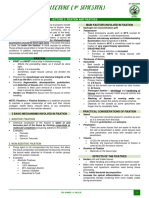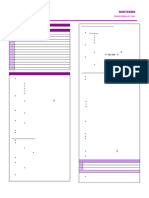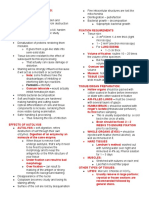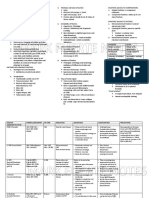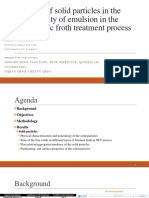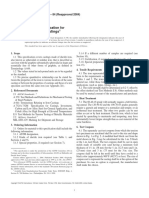2 Fixation, Decalcification & Dehydration
2 Fixation, Decalcification & Dehydration
Uploaded by
Nur-Reza MohammadCopyright:
Available Formats
2 Fixation, Decalcification & Dehydration
2 Fixation, Decalcification & Dehydration
Uploaded by
Nur-Reza MohammadCopyright
Available Formats
Share this document
Did you find this document useful?
Is this content inappropriate?
Copyright:
Available Formats
2 Fixation, Decalcification & Dehydration
2 Fixation, Decalcification & Dehydration
Uploaded by
Nur-Reza MohammadCopyright:
Available Formats
Enclonar, Kimberly / MLS 3A
▪ 10% neutral buffered formalin
Fixation, Decalcification & ▪ Heidenhain's Susa
Dehydration ▪ Formal sublimate (formal corrosive)
October 21, 2020 ▪ Zenker's solution
Gabriel Ponce de Leon, RMT, AMT, ASCPi, MS ▪ Zenker-formal (Kelly's solution)
▪ Bouin's solution
Histology Procedure ▪ Brasil's solution
1. Specimen Accessioning o Cytologic Fixatives
o Viability of sample ▪ Nuclear
o Pre-fixation □ Flemming's fluid
2. Gross Examination □ Carnoy's fluid
o Orient tissue in its original anatomical structure □ Bouin's fluid
o TAHBSO (total abdominal hysteroctomy - □ Newcomer's fluid
bilateral salpingoophorectomy) □ Heidenhain's Susa
o Organ or organ system ▪ Cytoplasmic
o Tubular or solid □ Flemming's fluid without acetic acid
3. Tissue Fixation □ Kelly's fluid
o Start of tissue biopsy □ Formalin w/o post-chroming
o A portion of the tissue only □ Orth's fluid
o Formaldehyde □ Regaud's fluid (Muller's fluid)
4. Tissue Processing ▪ Histochemical
o Dehydration □ 10% formal saline
o Clearing □ Absolute ethyl alcohol
o Impregnation □ Acetone
5. Tissue embedding □ Newcomer's fluid
6. Tissue sectioning
o Before: deparaffinization A Aldehyde Fixative
o After: fishing out in a float out bath • Formaldehyde
7. Slide staining o 37-40% stock solution
▪ Liquid form
Fixation ▪ Distilled water as diluent
o 10% working solution
• First and most critical step
o If tissue is too brittle, there will be a problem in o Advantage: cheap, easy to prepare and readily
cutting available
o At least 3 representative samples o Disadvantage: May produce considerable
shrinkage of tissues
• Ideal time to perform fixation: 20-30 minutes after
▪ May cause brittle tissues
interruption of blood supply
o Prevents autolysis • 10% Formol Saline
o For CNS tissues
• Correct fixative-tissue ratio - 20:1
o Advantage: Preserves enzymes and
• Usual fixation temperature: room temp
nucleoproteins, demonstrates fats and mucin
• Primary aim:
o Disadvantage: slow fixative
o To preserve the morphological and chemical
integrity of the cell in as life-like manner as • 10% buffered Neutral Formalin
o For post-mortem and research specimen
possible
o Advantage: Best fixative for tissue containing
• Secondary aim:
o To harden and protect the tissue from the iron pigments
o Disadvantage: It is longer to prepare.
trauma of further handling
• Formal Corrosive (FOR-SMOL-CHLOROSIVE)
o For routine post-mortem tissue
Classification of Fixatives
o Adv: Penetrates small tissues
• Physical fixative
o Heat o Disadv: Forms mercuric chloride deposits
o Freezing • Glutaraldehyde (GluEM)
o For electron microscopy
• Chemical Fixatives
o Simple fixatives o Adv: It preserves cellular structures
o Disadv: It is more expensive
▪ Aldehydes
□ Formaldehyde
□ Glutaraldehyde B Metallic Fixative
▪ Metallic fixatives • Chloride
□ Mercuric chloride o Most common metallic fixative
□ Chromate fixatives o May produce black granular deposits on tissues
▪ Picric acid (except SuSa)
▪ Acetone • Chromate
▪ Acetic acid o Preserves chromatin tissue
▪ Alcohol • Lead fixative
▪ Osmium tetraoxide o For acid mucopolysaccharide
▪ Osmic acid • Mercuric chloride
o Compound fixatives o Zenker's Fluid (w/ glacial acetic acid)
o Microanatomical fixatives (ZenGACTRICH)
▪ 10% formal saline ▪ Adv: Recommended for trichrome staining
Enclonar, Kimberly / MLS 3A
▪ Disadv: poor penetration • Inhibits hematoxylin and makes counterstaining
o Zenker-Formol (Kelly's solution) difficult
▪ Adv: Excellent for pituitary gland, bone • Produces black precipitate (osmic oxide)
marrow, spleen and liver • Prevention: add saturated aqueous HgCl2
▪ Disadv: Brown pigments are produced • Remedy: dissolve in cold water
▪ Brown pigments can be dissolved in • Flemming's
saturated picric acid or NaOH. o For nuclear structure
o Heidenhain's Susa • Flemming's with acetic acid
▪ For tumor biopsies of the skin o For cytoplasmic structures
▪ Adv: penetrates and fixes tissues rapidly
and evenly G Trichloroacetic acid
▪ Disadv: RBC preservation is poor • Both a fixative and decalcifying agent
o B5 Fixative (B5BMB)
▪ For bone marrow biopsies H Acetone (Asotone)
▪ Adv: rapid fixation can be achieved in 1 1/2 • Fixes brain tissues for the diagnosis of rabies
- 2 hrs
▪ Disadv: Over fixation hardens tissue I Heat Fixation
• Chromate • Direct flaming
o 1-2% Chromic acid o For bacterial smear
o 3% potassium dichromate (POTA DIMITO)
• Microwave fixation
▪ preserves mitochondria o Optimum temperature: 45-55C
o Regaud's (Mauller's)
▪ mitochondria, golgi apparatus
o Orth's fluid Decalcification
▪ For Rickettsia • Removal of calcium
▪ For study of early degenerative diseases • Bone, teeth, etc
• Lead Fixative • Recommended ratio of 20:1
o Alcian Blue (Alcid) • At 37C, impaired nuclear staining of Van Gieson's
▪ For acid mucopolysaccharide stain for collagen fibers
• At 55C, tissue will undergo complete digestion within
C Picrate Fixative 24-48 hrs
• Picrates are formed upon protein; precipitates are • Optimum temperature: RT (18-30C)
soluble in water; • Ideal time: 24-48 hrs
• Hence tissues must be first rendered insoluble by
direct immersion in 70% ETOH Methods of Decalcification
• Picrates fixative must never be washed in water Acid decalcifying agents
before dehydration • Nitric Acid
• 70% ethyl alcohol - 5% sodium thiosulfate - running o Most common
water o Fastest decalcifying agent
• Bouin's solution o Used for large or heavily mineralized cortical
o For embryos and pituitary biopsies bone specimen (aqueous nitric acid solution
o Adv: excellent for preserving soft and delicate 10%)
tissues o Examples:
o Disadv: penetrates larges tissues poorly ▪ Formol nitric
• Brasil's solution (BRAniGLYCO) □ urgent biopsies
o For excellent fixative for glycogen ▪ Perenyi's
o Adv: less messy □ tissue softener and decalcifying agent
▪ Phloroglucin-nitric acid
D Glacial Acetic Acid (GAA-Nucleo) □ Most rapid decalcifying agent
• Adv: Fixes and precipitates nucleoproteins • Hydrochloric acid
o Von Ebner's solution
• Disadv: destroys mitochondria and golgi apparatus
▪ Teeth and small pieces of bone
E Alcoholic Fixative • Formic acid
o Fixative and decalcifying agent
• Methyl alcohol o Formic acid-sodium citrate solution
o For dry and wet smears
▪ Recommended for autopsy materials, bone
• Isopropyl alcohol
marrow, cartilage and tissue studied for
o For fixing touch preparations
research purposes
• Ethyl alcohol
o 70-100% • Trichloroacetic acid
o Does not require washing out
• Carnoy's (fastest Car) o Is suitable for small spicules of bone
o most rapid fixative, fixation time 1-3hrs
o Weak decalcifying agent
• Newcomer's fluid
o Fixes mucopolysaccharide • Sulfurous
o Very weak decalcifying agent
• Chromic acid (Flemming's fluid)
F Osmium Tetraoxide o Fixative and decalcifying agent
• Should be kept in a dark-colored chemically clean
• Citric acid-citrate buffer solution
bottle to prevent evaporation and reduction by o Permits excellent nuclear and cytoplasmic
sunlight or organic matter staining; action is too slow for routine purposes
Enclonar, Kimberly / MLS 3A
Ion exchange resins with acid and decalcifying fluids o Utilized for urgent biopsies
• The removal of calcium ions from the decalcifying • Dioxane (diethylene dioxide)
fluid by the resins leads to quicker and more efficient o Dehydrating agent and a clearing agent
decalcification o Makes use of Graupner's method and
Weiseberger's method as a time schedule for
Electrolytic decalcification dehyration
• The speedier decalcification without damage to the • Cellosolve (Ethylene glycol monoethyl ether)
cytological features and staining o Combustible at 110-120F and are toxic by
• Drawback: heat produced in the process may cause inhalation, skin contact and ingestion
the charring of specimen in the process • Triethyl phosphate
• Tetrahydrofuran (THF)
Chelating agents o Dehydrating agent and a clearing agent, produce
a good staining results
Measuring the Extent of Decalcification • Carbon tetrachloride
• Physical or Mechanical Test o When heated produces a poisonous gas known
o Done by touching or bending the tissue with the as "Phosgene"
fingers to determine the consistency of tissues. • Methyl benzoate and methyl salicylate
o Alternative method is done by pricking the tissue o Slow acting clearing agents that can be used
with fine needle or probe when double embedding techniques are
• X-ray or Radiological Method required
o Most ideal, most sensitive and most reliable yet
it is the most expensive
o Has the ability to detect even the smallest focus
of calcium which appears opaque in an X-ray
plate
• Chemical Method (Calcium Oxalate Method)
o Simple, reliable and convenient method
o Involves the detection of calcium in acid
solutions by precipitation of insoluble calcium
hydroxide or calcium oxalate
Post-Decalcification
Can be done by:
• Neutralization
o Lithium carbonate solution or 5-10% aqueous
sodium bicarbonate
• Rinsing - tap water
• Blotting - tap water before transferring it into
dehydrating fluids
• Dehydration - 70% alcohol
Tissue Softeners
• Perenyi's fluid
o Decalcifying agent and tissue softener
• 4% aqueous phenol solution
o Immersion of tissue samples for 3 days
• Molliflex
o Commercially prepared
• 2% HCl or 1% HCl in 70% alcohol
Dehydration
• Aim: remove fixative and water from tissues and
replaced them with dehydrating agents
• In most instances, dehydration starts by placing the
specimen from 70% ethanol in water, progressing
through 95% ethanol to 100% ethanol
Commonly used:
• Alcohol (most common)
o Ethyl alcohol
▪ For routine dehydration
▪ Best dehydrating agent because it is fast-
acting
o Methyl alcohol
▪ For blood and tissue films
o Butyl alcohol
▪ For plant and animal microtechniques
• Acetone
o rapid acting dehydrating agent
You might also like
- Material Safety Data Sheet: 1. Identification of The Material and SupplierDocument5 pagesMaterial Safety Data Sheet: 1. Identification of The Material and Suppliersylvester rasheedNo ratings yet
- PD Cen TR 10261 - 2013Document36 pagesPD Cen TR 10261 - 2013umur kaçamaklıNo ratings yet
- HistopathDocument38 pagesHistopathDarla YsavelNo ratings yet
- Fasteners Handbook - Blacks - CatalogueDocument88 pagesFasteners Handbook - Blacks - CatalogueRobert Stuart100% (2)
- Formation Evaluation by Paul GloverDocument143 pagesFormation Evaluation by Paul GloverPraise Koobee100% (2)
- Histopathologic TechniquesDocument10 pagesHistopathologic TechniquesM C0% (1)
- HTMLE RecallsDocument3 pagesHTMLE Recallsninaalteres123No ratings yet
- Histopathologic TechniquesDocument11 pagesHistopathologic TechniquesGail SantanderNo ratings yet
- Midterms Bacte Lab NotesDocument11 pagesMidterms Bacte Lab NotesWinnie Gay UanangNo ratings yet
- SF-2 - Fixation and FixativesDocument9 pagesSF-2 - Fixation and FixativesFRANCIS ANDREI H. MIRANo ratings yet
- HISTOPATH-MODULE-4 NotesDocument7 pagesHISTOPATH-MODULE-4 NotesKaycee AyoNo ratings yet
- HP Lec - FixationDocument4 pagesHP Lec - FixationAaron Vincent MillomedaNo ratings yet
- 15 - AUBF (Lab) - Fecal AnalysisDocument5 pages15 - AUBF (Lab) - Fecal Analysisidoljl003No ratings yet
- HPCT Lec Week 3 - Fresh Tissue Examination, Special Tissue Processing, Fixation.Document3 pagesHPCT Lec Week 3 - Fresh Tissue Examination, Special Tissue Processing, Fixation.Marc Jeff GabasaNo ratings yet
- Histopathology MidtermDocument2 pagesHistopathology MidtermAncestral garmentsNo ratings yet
- Cytological TechniquesDocument4 pagesCytological TechniquesJamie100% (2)
- LABSDocument159 pagesLABSLordevin CabatlaoNo ratings yet
- Enzyme HistochemistryDocument4 pagesEnzyme HistochemistryKristine Baring50% (2)
- Impregnation and EmbeddingDocument2 pagesImpregnation and Embeddinglucky mark navarroNo ratings yet
- Decalcification Time: 2-7 DaysDocument3 pagesDecalcification Time: 2-7 DaysPork TapewormNo ratings yet
- Fixation of Histology SamplesDocument25 pagesFixation of Histology Sampleslalemchanie16No ratings yet
- Exam 1 Study GuideDocument29 pagesExam 1 Study GuideNishNo ratings yet
- HPCT 12 H&E Staining TechniqueDocument2 pagesHPCT 12 H&E Staining TechniqueAlthea Jam Grezshyl GaloNo ratings yet
- Parasitology Short Quiz 1.2Document2 pagesParasitology Short Quiz 1.2JAIRISH YZABELLE SALVADORNo ratings yet
- Drug IncompatibilitiesDocument8 pagesDrug IncompatibilitiesEmpanology GamesNo ratings yet
- Hema1 Mtap1Document6 pagesHema1 Mtap1tranatesophie4No ratings yet
- L4 Histopath LecDocument7 pagesL4 Histopath LecReginald ToribioNo ratings yet
- LAB Histopathologic-Technique EmbeddingInfiltration Finals 002Document3 pagesLAB Histopathologic-Technique EmbeddingInfiltration Finals 002Jashmine May TadinaNo ratings yet
- OoDocument5 pagesOoKaden MikaelNo ratings yet
- Is The Optimal Choice For Many Reasons.: FixativesDocument4 pagesIs The Optimal Choice For Many Reasons.: Fixativesbea gallardoNo ratings yet
- Precautions in Handling, Acceptance & Fixation of SpecimensDocument32 pagesPrecautions in Handling, Acceptance & Fixation of SpecimensMary ChristelleNo ratings yet
- Fixation GregorioDocument10 pagesFixation Gregoriobvrgs bvrgsNo ratings yet
- Hard TissuesDocument3 pagesHard TissuesKrizza UrmazaNo ratings yet
- Microscopic Examination of UrineDocument11 pagesMicroscopic Examination of UrineJheshari VinaNo ratings yet
- Histotechnology NotesDocument2 pagesHistotechnology NotesIyah ChingNo ratings yet
- ALLNOTES HistoDocument29 pagesALLNOTES HistoEricka GenoveNo ratings yet
- Histopath Techniques HandoutDocument16 pagesHistopath Techniques HandoutAndy MarquezNo ratings yet
- Histopath LectureDocument8 pagesHistopath LectureSandhya Narag SharmaNo ratings yet
- Histopathology Techniques UnfinishedDocument8 pagesHistopathology Techniques UnfinishedGianna SablanNo ratings yet
- InfiltrationDocument7 pagesInfiltrationbvrgs bvrgsNo ratings yet
- ANATOMICAL PATHOLOGY LABDocument36 pagesANATOMICAL PATHOLOGY LABMar Ràfols MartínezNo ratings yet
- Mtap 1 - HistopathDocument10 pagesMtap 1 - HistopathFaith SamonteNo ratings yet
- Liposome and NanotechnologyDocument77 pagesLiposome and NanotechnologydianNo ratings yet
- Notes On HistologyDocument4 pagesNotes On HistologyTiffany RemiendoNo ratings yet
- Histology ReviewerDocument5 pagesHistology Reviewerkmdynasty_No ratings yet
- 1 Decalcification of Calcified TissueDocument2 pages1 Decalcification of Calcified TissueAngel RamosNo ratings yet
- P7 - Proper Staining of Blood SmearDocument3 pagesP7 - Proper Staining of Blood SmearAlthea Jam Grezshyl GaloNo ratings yet
- Compre HistopatDocument21 pagesCompre HistopatMark FuerteNo ratings yet
- Decalcification and DehydrationDocument5 pagesDecalcification and DehydrationAudreySlitNo ratings yet
- FIXATIONDocument10 pagesFIXATIONIndestructible queenNo ratings yet
- Fresh Tissue ExaminationDocument51 pagesFresh Tissue ExaminationiaderzNo ratings yet
- Histopathology ReviewerDocument6 pagesHistopathology ReviewerDiamante MhayaleneNo ratings yet
- 7 HCT FixationDocument2 pages7 HCT FixationGwen Kirsten AtayanNo ratings yet
- Arian Velayati - FEB 20221Document48 pagesArian Velayati - FEB 20221Arian VelayatiNo ratings yet
- RT9 FinalsDocument17 pagesRT9 Finalscorrainnejimenez.24No ratings yet
- Specimen Collection MethodDocument5 pagesSpecimen Collection MethodChaerish Irich Say-aNo ratings yet
- Decalcification - SPC MLS 2B - Histopath LecDocument2 pagesDecalcification - SPC MLS 2B - Histopath Lecchristian Jay HorseradaNo ratings yet
- Aling Vicky MergedDocument62 pagesAling Vicky MergedFeilart FerrarisNo ratings yet
- GUID - 4 en-USDocument1 pageGUID - 4 en-USDilawar BakhtNo ratings yet
- Hstcyt Part2Document2 pagesHstcyt Part2Rafaela Mae Javellana GalesteNo ratings yet
- HISTOTECHNIQUESDocument20 pagesHISTOTECHNIQUESZIPPORAH JESSICA NONOGNo ratings yet
- 1 Intro To HematologyDocument2 pages1 Intro To HematologyAldrin ChrisNo ratings yet
- Decal-Clear NotesDocument3 pagesDecal-Clear NotesbarbiegahibNo ratings yet
- Load Analysis of A Bungalow by Christal Wong (Semester 4)Document45 pagesLoad Analysis of A Bungalow by Christal Wong (Semester 4)Christal WongNo ratings yet
- ASSIGNMENTDocument2 pagesASSIGNMENTmsmohamedabdullah63No ratings yet
- KW24317 Aghs enDocument6 pagesKW24317 Aghs enEdgar Uriel Castillejos DíazNo ratings yet
- Phychem Lab Assignment - R104 R105Document1 pagePhychem Lab Assignment - R104 R105vegamaharajfaith02No ratings yet
- 2010 Fracture Control Strategy For Conversion of O&G Pipelines To CO2Document12 pages2010 Fracture Control Strategy For Conversion of O&G Pipelines To CO2hefflingerNo ratings yet
- Gujarat Technological University: InstructionsDocument3 pagesGujarat Technological University: InstructionsRaj PatelNo ratings yet
- MCHW Vol 1 App F Web PDFDocument60 pagesMCHW Vol 1 App F Web PDFalejandraoy9No ratings yet
- CC SPW 01900 03Document70 pagesCC SPW 01900 03Cristi NeaguNo ratings yet
- Working Drawing Assignment 1Document8 pagesWorking Drawing Assignment 1YING TZY LEWNo ratings yet
- General NotesDocument2 pagesGeneral NotesRyan TagaNo ratings yet
- Astm A536 PDFDocument6 pagesAstm A536 PDFmatias aliagaNo ratings yet
- 25 KHZ 100 Watts Ultrasonic Cleaning TransducerDocument7 pages25 KHZ 100 Watts Ultrasonic Cleaning TransducerPRADEEP SNo ratings yet
- Unitt Test 3 Grade 7 Semester 2Document3 pagesUnitt Test 3 Grade 7 Semester 2Da23ll AlderichNo ratings yet
- MDCV #5 PresentationDocument69 pagesMDCV #5 PresentationNguyễn Văn HòaNo ratings yet
- FP 1200 PDFDocument1 pageFP 1200 PDFJeff Salinas ArcosNo ratings yet
- BMC Revision Capsule Notes by Shubham SirDocument182 pagesBMC Revision Capsule Notes by Shubham SirSantosh Kumar PaswanNo ratings yet
- Chemistry 14ADocument11 pagesChemistry 14AJong.Gun.KimNo ratings yet
- FT Shandong Luwei Pharmaceutical Rev 120421Document1 pageFT Shandong Luwei Pharmaceutical Rev 120421Control calidadNo ratings yet
- Astm A751-2007Document6 pagesAstm A751-2007Luis Hoyos AvalosNo ratings yet
- AASHTO R18Document34 pagesAASHTO R18Sardar KhudhurNo ratings yet
- Chapter 2 Mechanics of Metal CuttingDocument36 pagesChapter 2 Mechanics of Metal CuttingAvinash Ganesan67% (3)
- A Handbook of Art SmithingDocument232 pagesA Handbook of Art SmithingArtisan Ideas100% (4)
- 2.introduction To Polymer Engineering-2new TEPEDocument23 pages2.introduction To Polymer Engineering-2new TEPEKhunchaiNoomNo ratings yet
- General Hss End Mills Yg1Document60 pagesGeneral Hss End Mills Yg1bayuwiroNo ratings yet
- (PDF) HGH Vacuum-Induced Surface Freezing For The Freeze-Drying of The Human Growth Hormone: How Does NuDocument12 pages(PDF) HGH Vacuum-Induced Surface Freezing For The Freeze-Drying of The Human Growth Hormone: How Does Nushenzengexport1980No ratings yet
- 7-10 SWG Earthwire GTP PDFDocument1 page7-10 SWG Earthwire GTP PDFSamyak DeoraNo ratings yet









